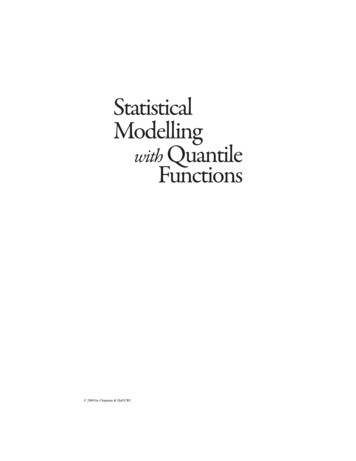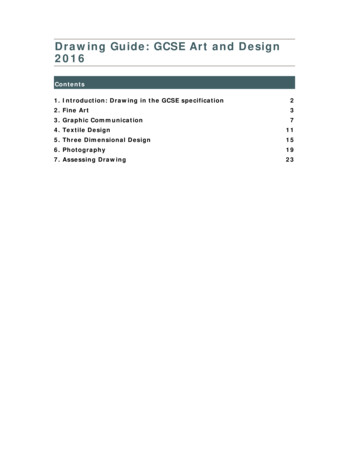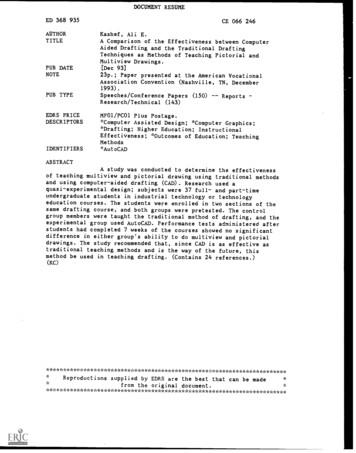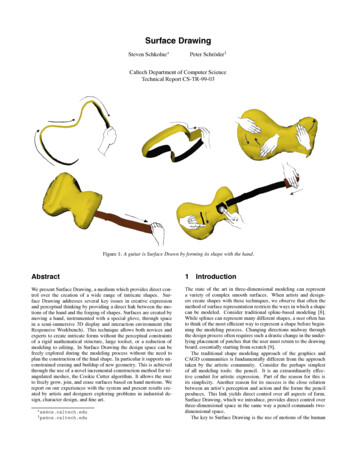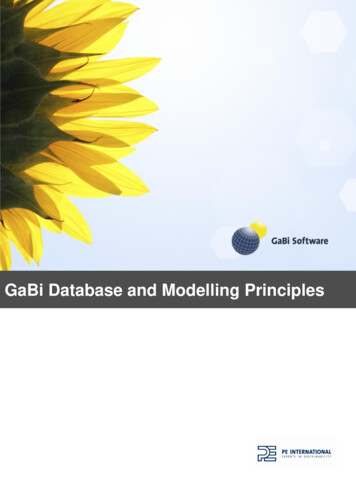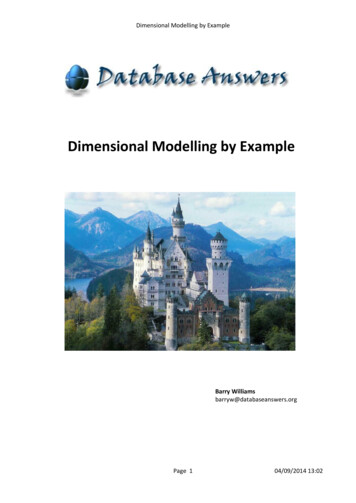
Transcription
Dimensional Modelling by ExampleDimensional Modelling by ExampleBarry Williamsbarryw@databaseanswers.orgPage 104/09/2014 13:02
Dimensional Modelling by Example1. Management Summary . 51.1 The Purpose of this Book. 51.2 The Contents of this Book . 51.3 Three Stages . 51.4 What are Dimensional Models ? . 51.5 Data Marts. 61.6 Best Practice . 71.7 Types of Dimensional Models . 71.8 How to use the Dimensional Models . 122. Getting Started . 122.1 Design Guidelines - a Four-Step Approach . 122.2 Always use Surrogate Keys . 122.3 Agree an Architecture . 132.4 Conceptual Data Models . 182.5 Using Dimensional Models for Reports. 212.6 Dates and Flattened Hierarchies . 223. Reaching Maturity . 233.1 Semantic Layer . 233.2 Self-Service BI. 253.3 Churn - Analysing Churn Rate . 253.4 Promotions – Analysing Promotions Effectiveness . 273.5 Conformed Dimensions . 293.6 Systems and Design Patterns . 303.7 Add new Requirements . 314. Keeping Things Ticking Over . 314.1 Governance . 31Page 204/09/2014 13:02
Dimensional Modelling by Example4.2 Data Quality. 314.3 User Involvement . 31Appendix A. Library of Dimensional Models . 32A.1 Advertising . 32A.2 Afghanistan Encounters . 34A.3 Airline Operations. 36A.4 American Studies . 38A.5 Amusement Parks . 40A.6 Anti Money-Laundering . 42A.7 Banking – Investment . 44A.8 Banking – Retail. 46A.9 Boy Scouts . 48A.10 Clown Registry . 50A.11 Commercial Properties . 52A.12 Cruise Ships . 54A.13 Customers and Car Parts . 56A.14 Day at the Olympics . 58A.15 Dog the Bounty Hunter . 60A.16 Dog Whisperer . 62A.17 Financial Services . 64A.18 Football . 66A.19 e-Commerce . 68A.20 Entertainment . 70A.21 Event Processing . 72A.22 Golf Memorabilia . 74A.23 Gym Training Diaries. 76A.24 Hotel Reservations . 78Page 304/09/2014 13:02
Dimensional Modelling by ExampleA.25 Insurance . 80A.26 Library Donations . 82A.27 Local Government . 84A.28 Logistics . 86A.29 Pharmaceutical Companies . 88A.30 Pool Hall Management . 91A.31 Property Tax Appeal . 93A.32 Public Transport . 95A.33 Puppies Tricks . 97A.34 Radio Stations . 99A.35 Recycling and Garbage Collection . 101A.36 Restaurant Guides . 103A.37 Retail . 105A.38 Student Registration . 107A.39 Telecomms Companies . 109A.40 Tracking Printer Cartridges . 111A.41 Traffic Cops and Tickets . 113A.42 Travel and Transport . 115A.43 Usual Suspects . 117A.44 Utilities . 119A.45 Vulnerable People . 121A.46 Waste Management . 123A.47 Wedding Parties . 125A.48 Wine . 127A.49 Yakuza – Japanese Organised Crime . 129A.50 Zoos . 131Page 404/09/2014 13:02
Dimensional Modelling by Example1. Management Summary1.1 The Purpose of this BookThe purpose of this book is to offer an introduction to Dimensional Modelling.It contains some background and theory and a Library of fifty Industry-specific Models tohelp you get started in creating something specific to your requirements.I also teach a Course and provide consulting services based on the contents of his Book.If you have questions or need help, please feel free to email me.1.2 The Contents of this BookThe contents of this book include all the major topics of interest in the area of DimensionalModelling.Conformed DimensionsFact TablesFactless FactsSelf-Service BIDimension apshots1.3 Three StagesThese Topics are covered in three Stages which are covered later in this Book :1. Getting Started2. Reaching Maturity3. Keeping Things Ticking Over1.4 What are Dimensional Models ?The concept of Dimensional Modelling was developed by Ralph Kimball.in response to ademand from end-users for an easy way to specify Reports.This contrasted with the alternative ‘Corporate Information Factory’, the vision ofBill Inmon.Page 504/09/2014 13:02
Dimensional Modelling by ExampleThis diagram shows a Dimensional Model that Ralph Kimball has published on his Web Sitefor a Retail Point of Sales : al-modeling-manifesto/It shows very clearly the approach which can be described very simply as “The data that canbe measured are called the ‘Facts’ and they are stored with the things that can be measuredby, which are called the the ‘Dimensions’.In this simple example. Kimball has kindly given all the Dimensions names ending‘Dimensions’, and there are three Facts that are called Dollars Sold, Units Sold and DollarsCost.1.5 Data MartsWe use the term ‘Data Mart’ as an alternative to ‘Dimensional Model’.We consider that they both mean the same but we sometimes use Data Mart ina way that might include more than one Dimensional Model, especially for afunctional area, such as Sales.We refer to the majority of our Models as Dimensional Models, but occasionallywe call them Data Marts which we prefer because it is more flexible.Page 604/09/2014 13:02
Dimensional Modelling by Example1.6 Best PracticeWhere appropriate, we consider the Kimball Web Site as our definitive source ofBest Practice in Data Modelling : http://www.kimballgroup.com/If you are looking for a good background, this page on Dimensional ModellingTechniques on the Kimball Web Site is highly recommended : onal-modeling-techniques/Wikipedia is usually worth a look, and here is the entry for DimensionalModelling : http://en.wikipedia.org/wiki/Dimensional modelingAn excellent writer is Chris Adamson who has published a great book called ‘StarSchema’ : http://www.amazon.com/s/ref nb sb noss/188-67989686571923?url search-alias%3Daps&fieldkeywords chris%20adamson%20star%20schemaAs a backup reference, we use Discussion Groups in LinkedIn like this one onDW Dimensional Modelling : https://www.linkedin.com/groups?gid 1435647&trk vsrp groups res name&trkInfo d%3A1435647%2CVSRPcmpt%3AprimaryIn LinkedIn, one good thing is that we can ask specific questions if we areseeking a majority view of Best Practice or Recommended Guidelines.1.7 Types of Dimensional ModelsWe can identify five distinct types of Dimensional Models which are discussed below : Accumulating Snapshot Tables Aggregate Tables Fact Tables Factless Fact Tables Snapshot TablesPage 704/09/2014 13:02
Dimensional Modelling by Example1.7.1 Accumulating Snapshot TablesA common example involves the use of a Stage or Status Dimension which is used to trackprogress through the Snapshots.In the first example, we have added a Stage Dimension and we add records at thesuccessive Stages of a Passenger’s progress1.7.1.1 Airline ExampleThis example of an Accumulating Snapshot Fact Table for Airline Operations shows how wecan track the progress of a Passenger.http://www.databaseanswers.org/data models/airline operations/accumulating snapshot.htmPage 804/09/2014 13:02
Dimensional Modelling by Example1.7.1.2 Student Registration ExampleHere we have added a Registration Stage Dimension to help us track registration with thehelp of this Accumulating Snapshot.http://www.databaseanswers.org/data models/student registration/accumulating snapshot.htm1.7.2 Aggregate FactsAggregates are created in response to the requirements of end-users.For example, Averages, Counts and Totals.We define these three as default in all our Fact Tables, as well as data for Key Performanceindicators (‘KPIs’). Graphs and TrendsPage 904/09/2014 13:02
Dimensional Modelling by Example1.7.3 Fact TablesFact Tables are the most common type and the majority of our Dimensional Models are FactTables.They store Dimension Data and Fact Data.1.7.4 Factless Fact TablesA Factless Fact is one that has no data associated with it. In other words, it has Dimensionsbut no Facts.A common example is an Event, where the occurrence of the Event is itself a Fact.Such as this Data Mart for Student Registration that we show here.http://www.databaseanswers.org/data models/student registration/student registration data mart model.htmPage 1004/09/2014 13:02
Dimensional Modelling by Example1.7.5 Snapshot TablesSnapshot Tables record historic data at periodic intervals, such as Day, Week ormonth.Here we show a Monthly Snapshot for Customers and Car Parts.http://www.databaseanswers.org/data models/customers and car parts/monthly snapshot.htmPage 1104/09/2014 13:02
Dimensional Modelling by Example1.8 How to use the Dimensional ModelsIn addition to Dimension Models, we have included Entity-Relationship Diagrams,which we show simply as ‘ERD’.For each ERD we have added a brief description of the Business Rules that definethe Entities or ‘Things of Interest’ and how they are related.This is very important because it helps the end-user to understand the kind ofdata that is available in a way that is easy and natural to understand.The first step in applying these Models to your own situation is Review the Business Rules Modify the ERD to reflect any changes you make to the Business Rules. Make the corresponding changes to the Dimensional Models.2. Getting Started2.1 Design Guidelines - a Four-Step ApproachGuideline : Follow Plan to establish controlled growth in your dimensional model.Here is one that is triggered by an Event or a Business Process1. Establish the users requirements.2. Determine the grain of the data3. Identify the Dimensions4. Identify the Facts2.2 Always use Surrogate KeysGuideline : Always use Surrogate Keys for Dimensional Models.Ralph Kimball (The father of Dimensional Modelling”) has published 10 Rules of DimensionalModelling.Number 8 states –“Make certain that dimension tables use a surrogate key”He has published a note on Surrogate Keys : /where he states that surrogate keys are essential for joining data in Fact Tables andDimension Tables.In other words, without Surrogate Keys there would be no Dimensional Models.They are a powerful technique and also offer excellent performance.Page 1204/09/2014 13:02
Dimensional Modelling by Example2.3 Agree an ArchitectureThis requires consensus on a Layered Data Architecture and Components.2.3.1 Data Architecture for the Semantic LayerThe Semantic Layer supports Self-service.This Architecture answers the question :“What is the role of the Semantic Layer ?”BI LayerSemantic Layer (Map technical to businessTerms, Glossary, Report Catalogue, etc.)Top-Level Data ModelDimensional Models/ Data MartsData WarehouseStaging AreaData SourcePage 1304/09/2014 13:02
Dimensional Modelling by Example2.3.2 Subject AreasHere we discuss the use of Subject Areas as a techniques for designing Dimensional Models.We take the simple example of Customers, Products and Revenue.This analysis shows that the three dominant Subject Areas are :1. Customers2. Products3. Revenue from Sales of Products to Customers.CustomersProductsRevenueThe Dimensional Models reflect these three Subject Areas.Page 1404/09/2014 13:02
Dimensional Modelling by Example2.3.3 Conformed DimensionsConformed Dimensions are shared between Tables and must have the same values inorder for Data to be retrieved satisfactorily.For example, date-stamped data in two tables must all be at the same level ofgranularity – for example, Days, Weeks or Months.Conformed Dimensions are therefore very important and are frequently Reference Data(such as Calendars) or Master Data (such as Products).Ralph Kimball (the father of Dimensional Modelling) has defined 10 Essential Rules : al-rules-of-dimensional-modeling/Rule Nr. 9 states :“Create conformed dimensions to integrate data across the enterprise”.CustomerCustomerDaily SnapshotConformedDimensionsCustomerProductsProduct SalesDaily SnapshotAddressesLocationsRevenueProduct SalesFactsPage 9/2014 13:02
Dimensional Modelling by ExampleThis diagram shows an example of Conformed Dimensions in a Customer Sales situation.These are the three Dimensions that are common (ie Conformed) to the two Dimension Models –Customer, Customer Segment and Product.CustomerContract DailySnapshotCustomerSegmentProduct SalesDaily SnapshotProduct (MDM)This diagram shows an example of Conformed Dimensions from the Data Mart from our Day at theOlympics.http://www.databaseanswers.org/data models/a day at the olympics/data marts with conformed dimensions.htmThis Data Mart features Conformed Dimensions for Calendar, Customers and Sports.2.3.4 Dimension Model TemplateDimensional Models are characterised by a Surrogate ID as the Primary Key.Without Surrogate ID Dimensional Models would not exist.Page 1604/09/2014 13:02
Dimensional Modelling by ExampleDimensional Models follow a generic design, based on Dimensions and Facts,where the dimensions and Facts are listed alphabetically :-Fact Table NameSurrogate ID (PK)Dimension 1 EntityDimension 1 (FK)Dimension 2 (FK)Dimension 1 (PK)Dimension 1 DetailsDimension 3 (FK)More DimensionsFact 1Fact 2Fact 3More FactsPage 1704/09/2014 13:02
Dimensional Modelling by Example2.4 Conceptual Data ModelsConceptual Data Models are very important for helping the end-user tounderstand the data that is available and the basic relationships.They complement the Dimensional Models.Conceptual Model are a very powerful technique to answer the question :“What Data is available in the Semantic Layer ?”2.4.1 Conceptual Data Model for Airline OperationsThis is specialty designed to be a ‘User-Friendly’ Model that shows the structureof the data that is available to support Analytics, Reports and BI requirements.It can be described as follows :Passengers make Reservations for Scheduled Flights operated by Airlines.They take Flights and make Payments which generate Revenue.AirlinesPassengersReservationsScheduled FlightsFlightsPaymentsRevenuePage 1804/09/2014 13:02
Dimensional Modelling by Example2.4.2 Conceptual Data Model for a Retail businessThis is also specialty designed to be a ‘User-Friendly’ Model.This one can be described as follows :Customers go to Stores and purchase Branded Products for which they makePayments which generate entsRevenuePage 1904/09/2014 13:02
Dimensional Modelling by Example2.4.3 Top-Level Data Model for a Telecomms businessThis one applies to a Telecomms Business and can be described as follows :Customers sign up for Subscriptions and then take out Contracts (orAgreements) to purchase Products which are made available through Offerings.They then use Networks which generates eementsNetwork UsageRevenuePage 2004/09/2014 13:02
Dimensional Modelling by Example2.5 Using Dimensional Models for Reports2.5.1 A Data Warehouse for Airport ManagementThis shows the Data Model for a Data Warehouse.In this Section, we discuss the Report that can be produced from this Data Warehouse.http://www.databaseanswers.org/data models/airport management/event driven data warehouse.htmPage 2104/09/2014 13:02
Dimensional Modelling by Example2.5.2 A Basic ReportWe can produce a count of Aircraft landing by Airline.2.5.3 Comparing Scheduled against Actual LandingsIf we want to produce a Report that compares Scheduled against Actual Landings we adddata from the Flight Schedules Table.2.6 Dates and Flattened HierarchiesWe normally show Dates as an Entity called Calendar.Because it is reference data, we name the Entity Ref Calendar :-When it is appropriate, we then expand normally show Dates as a Flattened Hierarchy like this :-Page 2204/09/2014 13:02
Dimensional Modelling by Example3. Reaching Maturity3.1 Semantic LayerThis is a good point at which to consider introducing a Semantic Layer.The primary purpose of a Semantic Layer (‘SL’) is to translate technical terms tobusiness terms which are familiar to end-users.For example, ‘Churn Rate’ instead of ‘Deactivation Count divided by CustomerCount’.Providing Self-Service BI makes it essential to provide a Semantic Layer.This diagram shows the Layered Data Architecture that we use as a point ofreference.This role clarifies the Role of the Semantic Layer.BI Layer (Analytics,Dashboards, Reports)Semantic Layer(Mapping Businessto Technical TermsDimensional Models /Data MartsData WarehouseBusiness Objects pioneered the SL concept, and in a Business Objectsenvironment, a Semantic Layer (‘SL’) can easily be implemented.Page 2304/09/2014 13:02
Dimensional Modelling by Example3.1.1 A Telecomms Semantic LayerA Semantic Layer for a typical Telecomms business is shown on this page :http://www.databaseanswers.org/data models/telecomms/components in a semantic layer.htmIt has three Data Marts :1. Customers2. Network Activity3. RevenueThe Customers Data Mart includes Churn data and the Network Activity includes Promotionsdata.We have used this data in the Self-Service BI that we discuss in the next Section.This shows the Churn Conceptual Model :-This shows the Promotion Conceptual Model :-Page 2404/09/2014 13:02
Dimensional Modelling by Example3.2 Self-Service BISelf-Service BI is a facility provided to end-users which allows them toselect the data they want and the Dashboard or Report they would like touse to see their data displayed.They can do this without depending on IT.Here we discuss how Dimensional Models can be used to provide data forSelf-Service BI.A Semantic Layer is an important part of Self-Service BI.It includes a Glossary of Terms, a Report Catalogue and a Semantic Layer.3.3 Churn - Analysing Churn Rate* http://www.databaseanswers.org/data models/retail customers/customers area model.htmit is proposed to set up a small application using a Key Performance Indicator (KPI) to monitor aChurn Rate.The KPI will have a defined Threshold value and when this value is reached an Alert will be sent to anominated end-user in the form of an email message.This email can be received on a mobile phone so that the end-user can be playing golf when hereceives the email.This shows how the principle of Management by Exception can be applied using today’s technology.3.3.1 What is a Churn Rate ?A Churn Rate is typically calculated as the total number of Deactivations (the Deactivation Count) ina given period, divided by the total number of Customers (the Customer Count).Page 2504/09/2014 13:02
Dimensional Modelling by Example3.3.2 SpecificationsThese Specifications will be reviewed and agreed or modified by the end-user.It is proposed that the Churn Rate will be monitored on a regular basis, such as daily or in real-time.Step 1) Define KPI and ThresholdStep 2) Define End-User and EmailStep 3) Monitor KPI and send EmailStep 4) User responds to EmailStep 5 User (optionally) Drills DownThe Self-Service supports the steps defined above, including :1. Define Key Performance Indicator as the Churn Rate with a user-specified Threshold valuesuch as 20%.2. Define end-user and email address.3.3.3 The Data3.3.3.1 Demonstration dataA small set of demonstration data will be created , following this template :Date and TimeKPI ValueThresholdValueRed/Amber/GreenAction09:00 Aug/01/ 201410:00 Aug/01/ 201411:00 Aug/01/ 201411:00 Aug/01/ 20145%10 %15 %20 %20%20%20%20%GreenGreenGreenRedDo nothingDo nothingDo nothingSend Email to end-user3.3.3.2 Drill-down dataIf it is decided to provide a drill-down facility, the required data will need to be provided.Page 2604/09/2014 13:02
Dimensional Modelling by Example3.4 Promotions – Analysing Promotions Effectiveness3.4.1 ApproachWe use the Layered Data Architecture in Chapter 5 to identify the activitiesinvolved in his Case Study.This shows the Layered Data Architecture that we use as a point ofreference.se it.This shows exactly how we use it.BI Layer – Analytics,Check what data is available.Dashboards, ReportsAdd what is necessary.Comply with format, content.Semantic Layer –Mapping Businessto Technical TermsDimensional ModelsAdd what is necessary,Comply with 2.1.1 Guidelines.Enhance Data Models,comply with GovernanceData Warehouse3.4.2 PurposeThe purpose of this Case Study is to provide a walk-through to show how to solve a specific BIrequirement.The requirement that we have chosen is to analyse the effectiveness of a Promotion.3.4.3 StepsStep 1. Determine the sources of the required data.Step 2. If it is in the Data Warehouse, then identify the Tables that will be involved.Step 3. Add Tables where required.Step 4. If it is not in the Data Warehouse, then identify the Data Sources and ensure goodquality and availability.Step 5. Identify the Dimensional Models involved.Step 6. Add Dimensions and Facts where required.Page 2704/09/2014 13:02
Dimensional Modelling by Example3.4.4 Tables in the Data WarehouseHere we have added a Table called ‘Product Promotion’ which has a Foreign Keyrelationship to the Product Table.Guidelines : Maintain the design approach of the existing Third-Normal Form DataWarehouse, with a surrogate ID field for the Primary Key.Barrys Product PromotionProduct Promotion IdProductProduct IdProduct Id (FK)Date FromDate ToProduct Price Percentage ReductionPromotion DescriptionPromotion ObjectivesPromotion AchievementsOther Promotion DetailsProduct NameProduct DescSAP Offering Id (FK)SAP Product Id (FK)Financial Material Id (FK)3.4.5 Conceptual View of the Product Sales Daily SnapshotHere we show a ‘User-Friendly’ version of the Table shown above.It tells us that we can analyse any of the Facts by any combination of the Dimensions.In particular, we can analyse sales of products in periods when there was a Promotion and periodswithout a Promotion.Product Sales Daily SnapshotDIMENSIONSContract StatusContractCustomerCustomer SegmentCustomer TypeDateMonthProductPromotionRetail OutletProduct BrandPayment TypePayment Type GroupFACTSContract Activation CountContract Deactivation CountSales AmountSales ValuePage 2804/09/2014 13:02
Dimen
‘Dimensions’, and there are three Facts that are called Dollars Sold, Units Sold and Dollars Cost. 1.5 Data Marts We use the term ‘Data Mart’ as an alternative to ‘Dimensional Model’. We consider that they both mean the same but we sometimes use Data Mart in a way that might include more than




